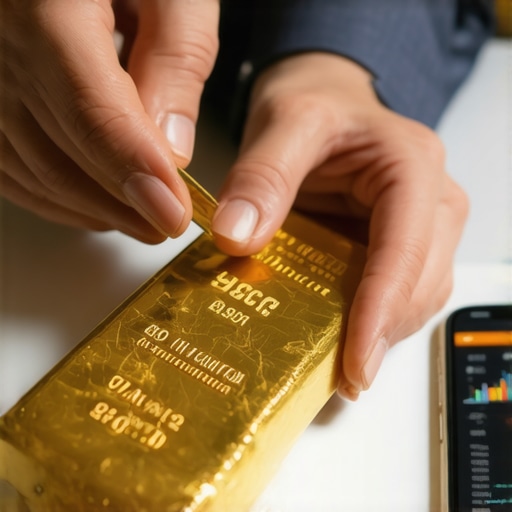Introduction to Gold Investment for New Investors
Investing in gold has long been considered a reliable way to build wealth and secure financial stability. For beginners, the prospect of entering the gold market can be daunting due to its complexities and perceived risks. However, understanding the fundamentals of gold investment can empower individuals to make informed decisions and potentially reap significant rewards. This guide aims to simplify the process of investing in gold, helping newcomers navigate the key aspects of this precious metal.
Why Invest in Gold?
Gold serves as a hedge against inflation and economic instability, making it a valuable addition to any investment portfolio. Its intrinsic value has remained resilient over time, unlike other forms of currency that may lose purchasing power. Additionally, gold is a tangible asset, which can be more comforting for investors wary of stock market volatility. With a variety of gold investment options available, such as physical gold, gold stocks, and ETFs, beginners can choose the method that aligns with their financial goals.
Understanding Different Types of Gold Investments
For those new to gold investing, it’s essential to understand the different types of investments available:
- Physical Gold: This includes gold bars, coins, and jewelry. Physical gold is a direct ownership option that allows you to hold gold in hand.
- Gold Stocks: Investing in companies that mine gold can provide exposure to gold prices without directly owning the metal.
- Gold ETFs: These exchange-traded funds mimic the price of gold and allow investors to trade shares on the stock market.
Each investment type has its pros and cons, and understanding these can help you make informed choices based on your risk tolerance and investment strategy.
Setting Your Investment Goals
Before diving into gold investments, it is crucial to establish clear investment goals. Are you looking for short-term gains, or are you focused on long-term wealth preservation? Understanding your risk tolerance is equally important, as it will guide your investment decisions. For instance, if you prefer a more stable investment, physical gold might be a suitable choice. In contrast, if you’re open to market fluctuations, gold stocks or ETFs might offer better growth potential.
Researching the Gold Market
Staying informed about the gold market is vital for successful investing. New investors should familiarize themselves with factors that influence gold prices, including economic indicators, geopolitical tensions, and central bank policies. Regularly reviewing market analyses and forecasts can provide insights into potential price movements. For a comprehensive understanding of market trends, consider exploring articles such as Gold Demand Insights and Analyzing Gold Market Trends.
Choosing Reputable Dealers and Platforms
Once you’ve decided on your investment type, the next step is to choose reputable dealers or investment platforms. Look for established companies with positive reviews and transparent pricing. Whether purchasing physical gold or trading stocks, ensure that you understand the fees involved and the platform’s credibility. Resources like How to Find the Best Gold Dealers can guide you in making informed choices.
In conclusion, investing in gold can be an excellent strategy for beginners looking to diversify their portfolios and protect their wealth. By understanding the different types of gold investments, setting clear goals, researching market trends, and selecting reputable dealers, new investors can navigate the gold market with confidence.
Understanding Gold Market Dynamics
To effectively navigate the gold investment landscape, it’s essential to grasp the dynamics that drive gold prices. Factors such as inflation rates, currency fluctuations, and global economic conditions can greatly influence the value of gold. For instance, during periods of economic uncertainty, gold often sees increased demand as investors seek stability. Understanding these market dynamics will allow you to make more informed decisions regarding your investments.
The Role of Central Banks in Gold Prices
Central banks play a significant role in gold pricing. Their policies, particularly regarding monetary supply and interest rates, can have profound effects on gold demand. For example, when central banks increase their gold reserves, it can signal confidence in gold as a safe-haven asset, leading to price increases. Investors should stay updated with analyses on central bank activities to understand how these actions might impact their gold investments.
Timing Your Gold Investments
Timing can be crucial when investing in gold. Understanding market cycles and price trends can help you make strategic decisions. Many investors use technical analysis to predict future price movements based on historical data. Moreover, being aware of seasonal trends can provide insights into optimal buying times. For instance, gold prices often rise during the holiday season as demand for jewelry increases. To learn more about price predictions, check out gold price forecasts.
Long-Term vs. Short-Term Investment Strategies
Your investment strategy should align with your financial goals. Long-term investors may focus on holding physical gold or gold ETFs, while short-term traders might prefer gold stocks or futures. Each strategy has its risks and rewards, so understanding your investment horizon is vital. For beginners looking to maximize their returns, consider reviewing strategies for maximizing gold investments.
Managing Risks in Gold Investment
Like any investment, gold comes with its own set of risks. Price volatility, geopolitical tensions, and changing regulations can impact your investments. To mitigate these risks, diversification is key. By spreading investments across different types of gold assets, such as physical gold, stocks, and ETFs, you can reduce potential losses. For further insights into risk management, visit gold investment strategies for risk management.
Using Gold as a Hedge Against Inflation
Gold is often regarded as a hedge against inflation. In periods of rising prices, gold tends to maintain its value while other assets may decline. This characteristic makes gold an appealing choice for investors looking to preserve their wealth. Understanding how to use gold effectively in an inflationary environment is crucial for long-term success. Explore the reasons for investing in gold as an inflation hedge to deepen your knowledge.
Conclusion: Taking the Next Steps in Gold Investment
As you embark on your gold investment journey, remember to stay informed and continuously educate yourself. Engaging with resources, market analyses, and expert opinions can significantly enhance your investment strategies. By understanding market dynamics, timing your investments wisely, managing risks, and recognizing gold’s role as a hedge against inflation, you can navigate the gold market with confidence and make informed decisions that align with your financial goals.
Exploring Advanced Gold Investment Techniques
As the gold market evolves, investors must adapt by employing advanced investment techniques. Understanding various approaches can improve your chances of success significantly. In particular, strategies such as gold options trading, futures contracts, and leveraged ETFs can provide unique advantages. These methods allow investors to capitalize on price movements while managing associated risks effectively. To delve deeper into these strategies, consider reading about gold futures strategies.
Diversifying Gold Investments: Beyond Physical Gold
Diversification is a cornerstone of effective investment strategy. While physical gold remains a popular choice, investors should also consider gold ETFs, mining stocks, and mutual funds. Each type of investment offers distinct benefits, such as liquidity and potential growth. By diversifying your portfolio with different gold investment types, you can mitigate risks while enhancing potential returns. For a comprehensive overview of gold investment types, check out diverse gold investments.
Utilizing Gold Mining Stocks for Portfolio Growth
Gold mining stocks present an excellent opportunity for investors looking to leverage the gold market’s growth. These stocks can provide significant returns, especially during bullish market conditions. However, it’s essential to analyze mining companies thoroughly, considering factors such as production costs, management quality, and geopolitical risks. For insights on selecting the best mining stocks, refer to top gold stocks for 2025.
The Importance of Staying Informed on Market Trends
Remaining updated with market trends is crucial for successful gold investments. Regularly reviewing expert analyses, economic indicators, and geopolitical developments can help you make informed decisions. For instance, understanding how shifts in global demand impact prices can prepare you for potential fluctuations. To access expert insights, visit gold market analyses that provide valuable information for investors.
Gold ETFs: A Smart Investment Choice in 2025
Gold ETFs have gained popularity due to their simplicity and lower fees compared to traditional gold investments. These funds offer exposure to the price of gold without the need to hold physical assets. Furthermore, gold ETFs can provide liquidity, making them an attractive option for both novice and experienced investors. To understand the pros and cons of gold ETFs, explore gold ETF insights. This resource can help you determine if gold ETFs align with your investment strategy.
Leveraging Economic Indicators in Gold Investment Decisions
Economic indicators such as inflation rates, interest rates, and currency strength are pivotal in determining gold prices. Investors who can interpret these indicators effectively can capitalize on market opportunities. For example, during periods of high inflation, gold often serves as a safe haven, driving demand. To learn how to analyze economic indicators for better investment decisions, read gold demand analysis.
Understanding the Role of Gold Demand in Market Fluctuations
To maximize your gold investment strategy, it’s essential to grasp how fluctuations in gold demand influence market dynamics. Factors such as global economic conditions, inflationary pressures, and geopolitical tensions significantly impact the demand for gold. For investors, keeping an eye on these trends can provide invaluable insights for making timely investment decisions. For a deeper understanding of gold demand, refer to essential gold demand insights.
Exploring Gold Trading Strategies for Enhanced Returns
Implementing effective gold trading strategies can significantly enhance your potential returns. Techniques such as swing trading, day trading, and long-term holding cater to different investor profiles and market conditions. By adapting your approach based on market analysis and individual risk tolerance, you can optimize your investment outcomes. For beginners looking to explore trading techniques, consider reading essential trading techniques.
Evaluating Gold Investment Types: A Comprehensive Overview
Investors face a variety of gold investment types, each with its own benefits and risks. Beyond physical gold, options include gold ETFs, mutual funds, and mining stocks. Understanding the nuances of each investment type helps investors align their strategies with their financial goals. If you’re interested in a thorough analysis of different gold investment types, check out a comprehensive overview of gold investments.
Utilizing Technology for Effective Gold Trading
In today’s digital landscape, technology plays a crucial role in gold trading. Advanced trading platforms and analytics tools allow investors to analyze market trends, execute trades efficiently, and manage their portfolios effectively. Embracing these technological advancements can lead to more informed decision-making and better overall investment performance. For insights on leveraging technology in trading, explore advanced trading techniques.
The Future of Gold Investment: Trends to Watch
As we look toward the future, several trends are shaping the gold investment landscape. Factors such as increasing central bank purchases, the rise of digital gold currencies, and shifts in consumer preferences are expected to influence gold prices and demand. Staying informed about these trends can help investors anticipate market movements and adjust their strategies accordingly. For expert predictions on future gold prices, visit the 2025 gold price forecast.
Mitigating Risks in Gold Investments
Risk management is a critical component of any successful investment strategy. In the gold market, potential risks include price volatility, regulatory changes, and market sentiment shifts. By employing strategies such as diversification, setting stop-loss orders, and conducting thorough research, investors can mitigate these risks effectively. For more tips on risk management, check out essential risk management strategies.
Frequently Asked Questions About Gold Investment
What are the main factors that influence gold prices?
Gold prices are influenced by various factors, including inflation rates, interest rates, currency strength, and geopolitical events. Additionally, changes in gold demand from central banks and consumer trends can significantly impact prices.
How can I start investing in gold?
Starting your gold investment journey can be done through multiple avenues, such as purchasing physical gold, investing in gold ETFs, or trading gold futures. It’s essential to choose an investment method that aligns with your financial goals and risk tolerance.
Is investing in gold a safe option?
Gold is often considered a safe-haven asset, especially during economic uncertainties. However, like any investment, it carries risks, such as price volatility and market fluctuations. Investors should conduct thorough research and consider diversifying their portfolios to mitigate these risks.
What are gold ETFs and how do they work?
Gold ETFs (Exchange-Traded Funds) are investment funds that hold gold assets and trade on stock exchanges, allowing investors to buy and sell shares like stocks. They offer a convenient way to gain exposure to gold prices without the need to store physical gold.
How often should I review my gold investment strategy?
Regularly reviewing your gold investment strategy is crucial, especially in response to market changes and personal financial goals. It’s advisable to assess your portfolio at least annually or during significant market shifts.
Can I invest in gold online?
Yes, numerous online platforms allow you to invest in gold through various means, including buying physical gold, gold coins, ETFs, or gold mining stocks. Ensure you choose a reputable platform with competitive fees and strong security measures.
What is the significance of gold in economic crises?
During economic crises, gold often serves as a hedge against inflation and currency devaluation. Its intrinsic value and global acceptance make it a preferred asset for preserving wealth when traditional investments falter.
How do I determine the best time to sell my gold investments?
Determining the best time to sell your gold investments involves analyzing market trends, economic indicators, and personal financial circumstances. Keeping abreast of market news and expert analyses can help inform your decision.
Are there tax implications for gold investments?
Yes, gold investments can incur taxes, typically classified as collectibles, which may be subject to higher capital gains tax rates. It’s essential to consult a tax professional to understand the implications based on your specific situation.
What are some common mistakes to avoid when investing in gold?
Common mistakes include failing to conduct adequate research, neglecting to diversify, and getting swayed by market emotions. Building a well-informed strategy and sticking to it can help avoid these pitfalls.
Authority Resources for Gold Investment Insights
To further enhance your understanding of gold investments, consider exploring these trusted resources:
- Investopedia – Gold Investing: An excellent resource for comprehensive articles on gold investment strategies, types, and market analysis.
- Kitco – Gold Market Information: Provides real-time gold prices, market news, and expert opinions on the gold and precious metals market.
- World Gold Council: A leading authority on gold, offering extensive research, reports, and insights on the gold market.
- Forbes: A reputable source for financial news and insights, including expert articles on gold investment trends.
- Bloomberg: Provides in-depth market data and analysis, including the latest news affecting gold prices and investment strategies.
Conclusion: The Strategic Approach to Gold Investment
In conclusion, navigating the gold investment landscape requires a deep understanding of market dynamics, effective strategies, and a keen eye on future trends. By exploring diverse investment types, leveraging technology for trading, and staying informed through authoritative resources, you can maximize your gold investment potential. Remember, the key to success in gold investment lies in staying updated with market changes and adapting your strategies accordingly. As you embark on or continue your gold investment journey, prioritize informed decision-making to enhance your financial outcomes.











As someone who’s recently started investing in gold, I found your guide incredibly enlightening. I’ve been focusing mostly on physical gold, but now I’m considering diversifying with gold ETFs, as they seem to have their advantages, especially liquidity and lower fees. It’s interesting how you mentioned that gold often acts as a hedge against inflation; I didn’t fully understand this until I started researching.
It’s also essential to be aware of the timing, as you’ve pointed out. I’ve noticed that prices fluctuate with market trends and economic indicators, so keeping informed is vital. I think the part about selecting reputable dealers and platforms cannot be stressed enough. I fell into the trap of rushing into a purchase without thoroughly reviewing a dealer’s reputation, which I now realize can be quite risky. I believe continuous learning and adapting our strategies is important for long-term success. Thanks for laying out these insights so clearly; it truly helps beginners like me navigate this complex market more confidently.
Jonathan, I completely resonate with your experience regarding the importance of choosing reputable dealers. Diving into gold investments without fully vetting the sources can definitely lead to unexpected challenges. One thing I’d add from my own journey is how crucial it is to understand not only the type of gold investment but also your personal financial timeline. For example, physical gold offers tangible security but can be less liquid compared to ETFs or stocks, which might better suit shorter-term strategies.
Another point to consider is the impact of central bank activities on gold prices, as the article highlighted. Watching how central banks adjust their holdings can offer insights beyond what basic market trends suggest. Also, keeping an eye on economic indicators like inflation really helps tailor your approach, especially since gold’s role as a hedge is so context-dependent.
As someone who initially overlooked market timing complexities, I now pay closer attention to seasonal demand and geopolitical events before making moves. Continuous education truly is vital here. How do others balance their investment horizon with the fluctuating nature of gold prices, especially when deciding between physical gold and ETFs? I’d be interested in hearing diverse strategies for managing liquidity and market timing in this space.